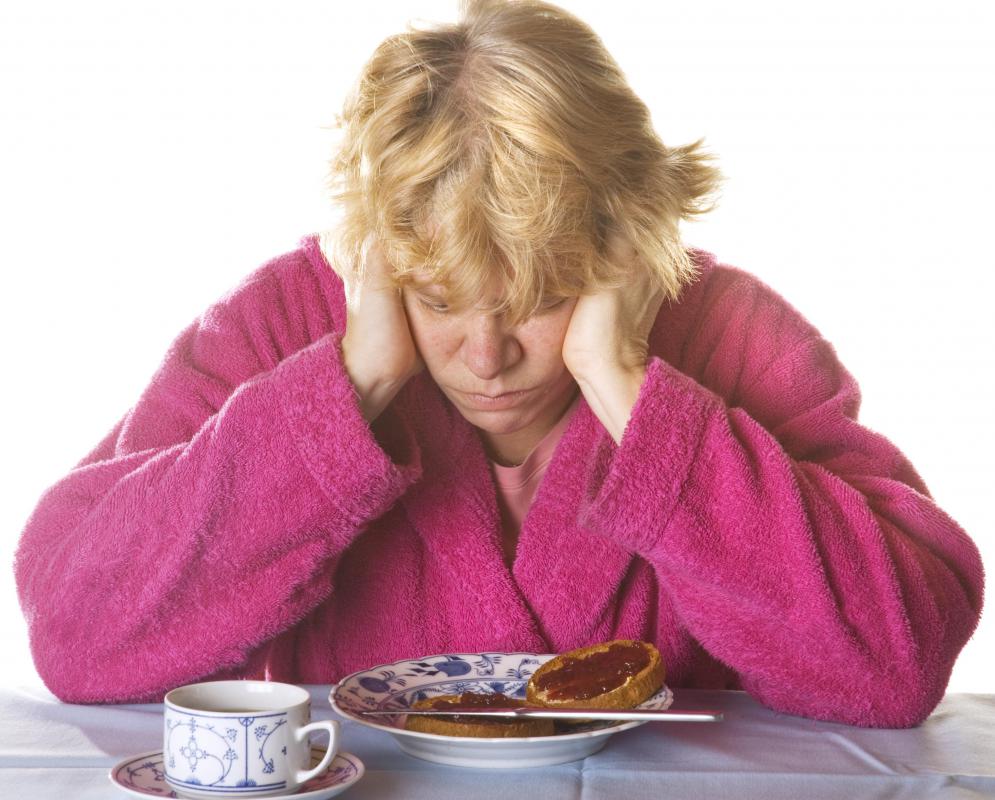At TheHealthBoard, we're committed to delivering accurate, trustworthy information. Our expert-authored content is rigorously fact-checked and sourced from credible authorities. Discover how we uphold the highest standards in providing you with reliable knowledge.
What Is Female Hysteria?
Female hysteria was a common medical diagnosis assigned specifically to women to describe a set of symptoms including lightheadedness, nervousness, insomnia, loss of appetite, and a wide range of others. The diagnosis was common and commonly discussed in the 19th century, though it was accepted as a real and serious malady for hundreds of years before that. Female hysteria is no longer accepted by the medical community as a correct or reasonable diagnosis. "Hysteria" was often used as a catch-all diagnosis that reflected the lack of knowledge of the diversity and complexity of psychological conditions, and increased knowledge has since led to more precise diagnoses.
No single, precise list of symptoms existed by which medical professionals could classify cases of female hysteria. In many cases, any combination of poorly-defined symptoms or even patterns of behavior that differed from societal expectations could be labeled as female hysteria. In some cases, the "afflicted" women were prompted to seek treatment for aberrant behavior by the men in their lives, such as fathers, husbands or others, whether or not the women experienced any discomfort or believed themselves to be somehow ill. The nature of the diagnosis of the condition generally reflected the nature of gender relationships at least as much as it reflected the inadequacy of knowledge in the area of psychological diagnostics.

The common treatments for female hysteria also reflect the gender relationships of the times when the "condition" was prevalent. Doctors would administer "pelvic massage," or manual stimulation of the female genitals, until the "afflicted" individual reached a state of "hysterical paroxysm," now understood as an orgasm. It was not generally considered possible to cure hysteria, so an "afflicted" woman would need to seek this form of treatment on a regular basis. A variety of devices were invented to make this treatment process more efficient and more comfortable for both the patient and the individual administering treatment.

Cases of this disorder dropped substantially during the early 20th century. Increased knowledge and acceptance of psychology led to a slightly better understanding of the nature of the disorder. Physicians and psychologists came to understand a broader range of more specific psychological disorders that took the place of a broad diagnosis of hysteria. Freudian psychoanalysis provided another approach to treatment and sought to demonstrate that many cases of female hysteria were actually neuroses based on some form of anxiety or on a traumatic past event in the afflicted individual's life.
AS FEATURED ON:
AS FEATURED ON:














Discussion Comments
@cardsfan27 - I can see your point, but I can also see that there is a possibility that female hysteria is simply a broad array of things that can fall into the category of female hysteria.
I see that this article talks about female orgasms and I have seen something on television where there are woman that exhibit some signs of female hysteria and it is because they have a problem with their body and they exhibit dozens of orgasms a day.
I feel like this is something that falls into the category of female hysteria and there are probably many other things that do too.
I truly believe that female hysteria is something that simply comes from the stereotypes that most men have of women as being very unreasonable and prone to bouts of becoming hysterical and not being able to handle things.
I feel like there are women out there that may consistently fit this description, but is that female hysteria or is that simply something else like some possible psychological problem?
I think that female hysteria is a really broad term that delves into pseudo science and is not a legitimate and proper diagnosis of whatever is wrong with the woman.
@titans62 - You are absolutely right. Back in those times it was fully acceptable for people to view a woman as being very frivelous and unreasonable and susceptible to moments of madness.
I have read of various sad and depressing incidents of husbands getting revenge on their wives by claiming constant female hysteria and the wife being sent to a mental institution simply on the word of their husbands.
With advancements in psychology and sociology people have become the wiser to these attempts and the movement to give women more rights eliminated cases like this happening.
Unfortunately this era of history is still there and lasted for centuries. Courts accepted the word of husbands and thousands of women in the past have had their lives ruined due to the diagnosis of female hysteria.
I am a history major and it amazes me to see the tendency of people as courts to accept pseudo science as pure fact and in reality ruin people's lives.
I have read numerous instances in the past of women being confined to mental institutions or jails simply due to exhibiting cases of female hysteria or simply refusing to do what their husbands told them to do.
Sometimes men would simply do this in order to get rid of their wives because they are mad at them for one reason or another or feel like they need to get revenge on them.
Since women were considered property they could do this and make wild accusations without much the woman could do to defend themselves.
It is definitely a different time that we live in and it is a good thing that knowledge on the subject of psychology has progressed and evolved the way it has for the better.
@Mae82 - If you want to see something funny you should look up some of the images that advertised medical services for female hysteria. I saw one that advertised a take home cure and in the advertisement the lady was standing while looking quite disinterested, despite the fact that her husband had his hand up her skirt using whichever tool he had purchased.
It is rather shocking really when you think about how prudish the Victorian area is perceived to be that such items were freely available for sale. I guess though, that when things are disguised as a medical treatment it is much more easily accepted.
I did a paper on female hysteria a little while ago and it amazes me at how far we have come when it comes to medicine. Our understanding of human anatomy, and of female anatomy in particular has made some amazing strides over the last few hundred years and that it really makes me wonder what we'll come up with next.
An interesting thing about the old treatments for female hysteria is that without such a medical condition we may not have the vibrators we have today. It seems funny to me that doctors were the first ones to really point out that women need pelvic attention or they suffer from all sorts of mood disorders.
Post your comments